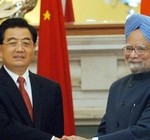India and China have been strategic rivals ever since they fought a brief but fierce war in 1962. Now tensions between them are hotting up again.
On land, fourteen rounds of negotiations have failed to resolve the disputed border. According to media reports, border incidents have intensified and India recently deployed extra troops and combat aircraft to contested regions. A recent visit by the Dalai Lama to Arunachal Pradesh—the Indian state claimed by China—was stridently denounced by Beijing, which also tried unsuccessfully to block an Asian Development Bank aid project there.
At sea, there are signs China is failing to acknowledge legitimate Indian interests in its own immediate region. The prospect of competition for maritime dominance in the Indian Ocean is growing as China rapidly develops powerful blue-water naval forces and builds its presence in locations of strategic concern to India such as Myanmar and Sri Lanka.
In October 2009 China’s state-run media turned up the heat on New Delhi, with an editorial in the People’s Daily accusing India of provocative behaviour over border issues and of aspiring to hegemony. It is hard to avoid the conclusion that China’s leaders have started to take seriously the emergence of India as a serious competitor for influence across Asia. Some commentators are even warning of the possibility of renewed conflict.
Although relations between India and China are likely to remain difficult, there are reasons for them to keep their rivalry in check. Two-way trade is growing fast and last year was worth US$52 billion. Asia’s two rising powers are both resisting Western pressure to accept binding carbon emissions targets at Copenhagen. They share interests ranging from the promotion of energy security through to combating jihadi terrorism and piracy. Moreover, it may be that Beijing’s recent posturing is out of step with mainstream opinion in China.
A recent poll of Chinese public attitudes to regional security, conducted by the Lowy Institute with support from the MacArthur Foundation, found that India ranked relatively lowly as a perceived threat in China. The poll—which Chinese media organisation Xinhua, censored—found only 34 percent of Chinese adults said that India posed a threat to China’s security in the next ten years, while 60 percent said it did not. This compares with 50 percent who thought the United States posed a threat and 45 percent who considered Japan a threat. Of five countries, only 14 per cent thought India was likely to pose the greatest threat to China’s security in the next decade.
Despite Beijing’s increasingly assertive diplomacy—which is being felt around the region, not just by India—it seems that China’s people remain preoccupied mostly with internal issues which affect their material living conditions. This conclusion is supported by the Lowy Institute poll, which found that of nine possible threats, it was environmental issues such as climate change followed by water and food shortages that most worried Chinese people. So the authoritarian leadership in Beijing may be out of step with domestic opinion when it beats the India drum.
Another lesson from the Lowy Institute poll may be that while the Communist Party remains implacably opposed to any form of genuine political freedom and plurality in China, the gap between the Chinese people and liberal democracies such as India, the United States and Australia might be smaller than commonly assumed. The values America holds and promotes ranked a clear last as an explanation for those Chinese who saw the United States as a threat, and the poll also revealed a surprisingly positive response to Australia’s liberal democratic model, with 57 percent agreeing Australia has a good political system and 68 percent agreeing that it has attractive values. Perhaps the Chinese people are genuinely, if quietly, attracted to models such as India’s that offer political as well as economic freedom. The fact the Chinese media censored a press release in December summarising the poll’s findings highlights the fear that the leadership has about these types of sentiments.
Of course public opinion does not always have the last word in determining foreign policy—least of all in China. As both countries rise, friction between New Delhi and Beijing is inevitable. Both governments will have a responsibility to manage those strains. In doing so New Delhi can draw at least some comfort from knowing that, irrespective of the rhetoric emanating from Beijing, China’s population does not necessarily see India as a threat and indeed shares some of the same concerns and aspirations.
This article was originally published by Pragati. You can read the rest of the article here.
You can read exclusive content from Gateway House: Indian Council on Global Relations, here.
Copyright © 2010 by Pragati.


